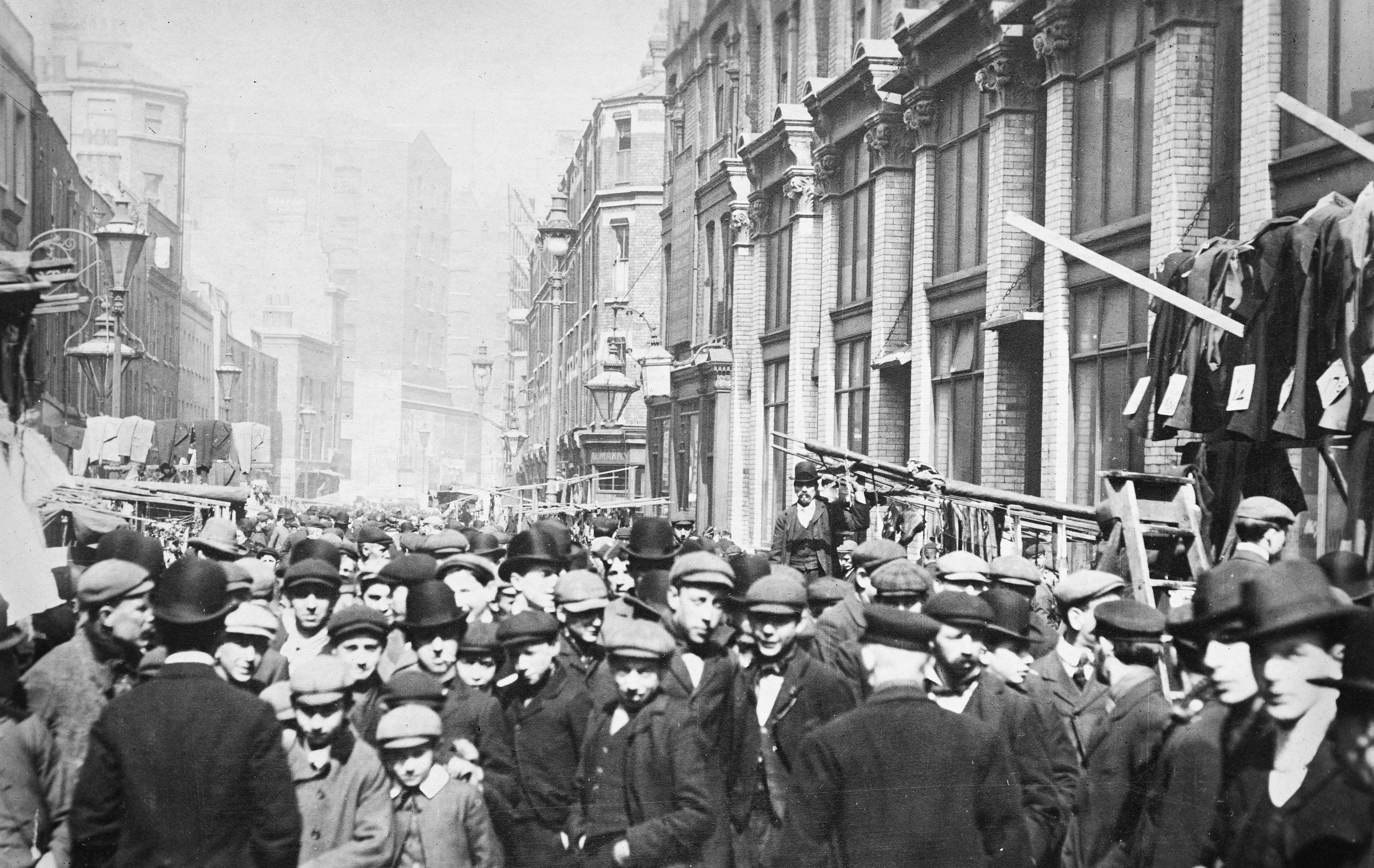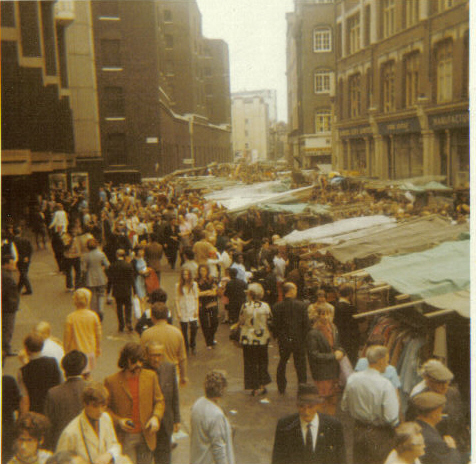Petticoat Lane Market on:
[Wikipedia]
[Google]
[Amazon]
Petticoat Lane Market is a fashion and clothing market in Spitalfields, London. It consists of two adjacent street markets. Wentworth Street Market is open six days a week and Middlesex Street Market is open on Sunday only.



''whitechapelsociety.com''
/ref> As late as the 1990s, if Christmas Day fell on a Sunday (which in that decade only occurred in 1994), many of the local Jewish traders would still assert their right to open on a Sunday. 'The Lane' was always renowned for the 'patter' and showmanship of the market traders. Some, selling crockery, would pile an entire setting onto a large plate, and then send the lot, high into the air. Catching the construction on its way down was to demonstrate the skill of the vendor, and the robustness of the porcelain. A prominent businessman,
File:Een standwerker prijst zijn koopwaar aan, Bestanddeelnr 191-0928.jpg, 1947
File:Overzicht van de markt, Bestanddeelnr 191-0964.jpg, 1947
File:Petticoat Lane London 1971 (1).jpg, 1971
File:Petticoat Lane Market - geograph.org.uk - 1164638.jpg, 2009
File:Towerblocks viewed from Middlesex Street - geograph.org.uk - 1704305.jpg, 2010
File:View of the Gherkin and buildings on Middlesex Street from Petticoat Lane Market - geograph.org.uk - 1704240.jpg, 2010
The modern market
It is one of a number of traditional markets located to the east of theCity of London
The City of London is a city, ceremonial county and local government district that contains the historic centre and constitutes, alongside Canary Wharf, the primary central business district (CBD) of London. It constituted most of London f ...
. A few hundred yards to the north is Old Spitalfields Market
Old Spitalfields Market is a covered market in Spitalfields, London. There has been a market on the site for over 350 years. In 1991 it gave its name to New Spitalfields Market in Leyton, where fruit and vegetables are now traded. In 2005, a re ...
, which has been refurbished, and across Commercial Street, to the east, lies Brick Lane Market
Brick Lane Market is the collective name for a number of London markets centred on Brick Lane, in Tower Hamlets in east London. The original market was located at the northern end of Brick Lane and in the heart of east London's Bangladeshi c ...
. A half mile further east is the Columbia Road Flower Market. Petticoat Lane Market was not formally recognised until an Act of Parliament
Acts of Parliament, sometimes referred to as primary legislation, are texts of law passed by the Legislature, legislative body of a jurisdiction (often a parliament or council). In most countries with a parliamentary system of government, acts of ...
in 1936, but its long history as an informal market makes it possibly one of the oldest surviving market
Market is a term used to describe concepts such as:
*Market (economics), system in which parties engage in transactions according to supply and demand
*Market economy
*Marketplace, a physical marketplace or public market
Geography
*Märket, an ...
s in Britain
Britain most often refers to:
* The United Kingdom, a sovereign state in Europe comprising the island of Great Britain, the north-eastern part of the island of Ireland and many smaller islands
* Great Britain, the largest island in the United King ...
.
The market is open Monday to Friday on Wentworth Street; on Sunday it extends over many of the surrounding streets, with over a thousand stalls. It is closed on Saturday, and on Sunday closes at about 2 pm. The markets are well signed from local stations. Petticoat Lane market is listed as a tourist attraction on VisitLondon.com, the official visitor guide for London. The name Petticoat Lane came from not only the sale of petticoats but from the fable that "they would steal your petticoat at one end of the market and sell it back to you at the other."
History of the market
In Tudor times, Middlesex Street was known as Hogs Lane, a pleasant lane lined by hedgerows and elms. It is thought city bakers were allowed to keep pigs in the lane, outside the city wall; or possibly that it was an ancientdroving
Droving is the practice of walking livestock over long distances. It is a type of herding. Droving stock to market—usually on foot and often with the aid of dogs—has a very long history in the Old World. An owner might entrust an agent to de ...
trail. The lane's rural nature changed, and by 1590, country cottages stood by the city walls. By 1608, it had become a commercial district where second-hand clothes and cheap goods were sold and exchanged, known as 'Peticote Lane'. This was also where the Spanish ambassador had his house, and the area attracted many Spaniards from the reign of James I James I may refer to:
People
*James I of Aragon (1208–1276)
*James I of Sicily or James II of Aragon (1267–1327)
*James I, Count of La Marche (1319–1362), Count of Ponthieu
*James I, Count of Urgell (1321–1347)
*James I of Cyprus (1334–13 ...
. Peticote Lane was severely affected by the Great Plague
The Black Death (also known as the Pestilence, the Great Mortality or the Plague) was a bubonic plague pandemic occurring in Western Eurasia and North Africa from 1346 to 1353. It is the most fatal pandemic recorded in human history, causi ...
of 1665; the rich fled, and London lost a fifth of its population.



Huguenots
The Huguenots ( , also , ) were a religious group of French Protestants who held to the Reformed, or Calvinist, tradition of Protestantism. The term, which may be derived from the name of a Swiss political leader, the Genevan burgomaster Be ...
fleeing persecution arrived in the late 17th century; many settled in the area, and master weavers settled in the new town of Spitalfields. The area already had an association with clothing, with dyeing
Dyeing is the application of dyes or pigments on textile materials such as fibers, yarns, and fabrics with the goal of achieving color with desired color fastness. Dyeing is normally done in a special solution containing dyes and particular c ...
a local industry. The cloth was pegged out on hooks in the surrounding fields. These were known as tenterground
A tenterground, tenter ground or teneter-field was an area used for drying newly manufactured cloth after fulling. The wet cloth was hooked onto frames called " tenters" and stretched taut using " tenter hooks", so that the cloth would dry fl ...
s. From the mid-18th century, Petticoat Lane became a centre for manufacturing clothes. The market served the well-to-do in the City, selling new garments. About 1830, Peticote Lane's name changed to Middlesex Street, to record the boundary between Portsoken Ward, in the City of London
The City of London is a city, ceremonial county and local government district that contains the historic centre and constitutes, alongside Canary Wharf, the primary central business district (CBD) of London. It constituted most of London f ...
, and Whitechapel
Whitechapel is a district in East London and the future administrative centre of the London Borough of Tower Hamlets. It is a part of the East End of London, east of Charing Cross. Part of the historic county of Middlesex, the area formed ...
, which coincided with the Lane. But the old name continues to be associated with the area.
From 1882, a wave of Jewish
Jews ( he, יְהוּדִים, , ) or Jewish people are an ethnoreligious group and nation originating from the Israelites Israelite origins and kingdom: "The first act in the long drama of Jewish history is the age of the Israelites""The ...
immigrants fleeing persecution in eastern Europe settled in the area. The chapels, which had previously served the Huguenot community, were adapted as synagogues. Many Jewish relief societies were founded to aid the poor. Jewish immigrants entered the local garment industry and maintained the traditions of the market. The severe damage inflicted throughout the East End during the Blitz
The Blitz was a German bombing campaign against the United Kingdom in 1940 and 1941, during the Second World War. The term was first used by the British press and originated from the term , the German word meaning 'lightning war'.
The Germa ...
and later bombing in World War II
World War II or the Second World War, often abbreviated as WWII or WW2, was a world war that lasted from 1939 to 1945. It involved the vast majority of the world's countries—including all of the great powers—forming two opposing ...
served to disperse the Jewish communities to new areas. The area around Middlesex Street suffered a decline, but the market continued to prosper. Beginning in the 1970s, a new wave of immigration from India and east Asia restored the area's vitality - centred on nearby Brick Lane.
In previous times the market was unpopular with the authorities, as it was largely unregulated and in some sense illegal. As recently as the 1930s, police cars and fire engines were driven down The Lane, with alarm bells ringing, to disrupt the market. The rights of the market were finally protected by Act of Parliament
Acts of Parliament, sometimes referred to as primary legislation, are texts of law passed by the Legislature, legislative body of a jurisdiction (often a parliament or council). In most countries with a parliamentary system of government, acts of ...
in 1936./ref> As late as the 1990s, if Christmas Day fell on a Sunday (which in that decade only occurred in 1994), many of the local Jewish traders would still assert their right to open on a Sunday. 'The Lane' was always renowned for the 'patter' and showmanship of the market traders. Some, selling crockery, would pile an entire setting onto a large plate, and then send the lot, high into the air. Catching the construction on its way down was to demonstrate the skill of the vendor, and the robustness of the porcelain. A prominent businessman,
Alan Sugar
Alan Michael Sugar, Baron Sugar (born 24 March 1947) is a British business magnate, media personality, author, politician and political adviser. In 1968, he started what would later become his largest business venture, consumer electronics com ...
, got his start as a stall holder in the market. The market remains busy and vibrant, reflecting both its immigrant history and its continuing popularity with locals and tourists.
Transport
* Aldgate East Underground station * Aldgate Underground station * Liverpool Street Station * The area is well served by buses, on Bishopsgate and Aldgate and Whitechapel High Streets * Parking restrictions apply, throughout the area, on all days of the weekGallery
See also
*Marketplace
A marketplace or market place is a location where people regularly gather for the purchase and sale of provisions, livestock, and other goods. In different parts of the world, a marketplace may be described as a '' souk'' (from the Arabic), ' ...
*Retail
Retail is the sale of goods and services to consumers, in contrast to wholesaling, which is sale to business or institutional customers. A retailer purchases goods in large quantities from manufacturers, directly or through a wholesaler, and ...
*Tenterground
A tenterground, tenter ground or teneter-field was an area used for drying newly manufactured cloth after fulling. The wet cloth was hooked onto frames called " tenters" and stretched taut using " tenter hooks", so that the cloth would dry fl ...
References
{{London markets Retail markets in London Spitalfields